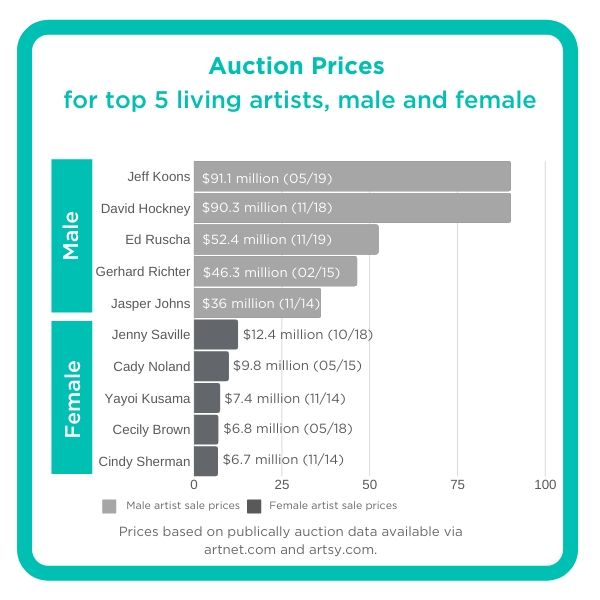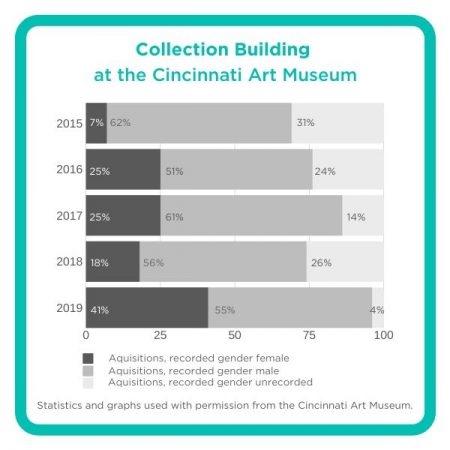Muses and makers: Women rise in the art market
Something is stirring for female artists. In October 2018, British artist Jenny Saville’s 1994 painting Propped sold for $12.4 million at Sotheby’s London, achieving a record price for a living female artist at auction.1 This year, Polish-born Modernist Tamara de Lempicka’s popularity has taken off. First, she became the first female artist to grace the front cover of an auction catalogue. Then, her stylized art deco 1932 portrait of Marjorie Ferry became the top selling lot of Christie’s January 2020 Impressionist and Modern sale at £16.3 million ($21.2 million). This record price eclipsed her prior record price, set only two months prior at Sotheby’s for $13.3 million.2,3 Meanwhile, in the world of emerging artists, the market is abuzz with news that recent Venice Biennial artist Avery Singer has signed with blue chip gallery Hauser & Wirth and sold out the gallery’s booth at the Frieze Los Angeles art fair. And her 2019 record price at Sotheby’s for $735,000 was over six times its high estimate.4
These three examples of record prices for female artists (established, historical and emerging) have been becoming the norm rather than the exception. Yet while women have been having a moment in the market, there are still many factors that must work together to continue to turn the tide for female artists.
Prices for female artists: Where’s the money?
Saville’s $12.4 million is the record price for a living female artist at auction. So what’s the record auction price for a living male artist? That number, achieved when Jeff Koons’ sculpture Silver Rabbit sold at Christie’s in 2019, is $91.1 million (you can watch our recap of this and other notable auction sales for spring 2019 here). 
One might argue that the price delta between male and female artists is more a function of the historical importance of an artist than a gender issue. Yet when one reviews the prices of important living artists, a significant price differential still exists.
“Why have there been no great female artists?” asked art historian Linda Nochlin in a famous 1971 essay in ARTnews magazine.5 She asserts that the reasons female artists have been forgotten in history books, exhibitions and collections go beyond a historical lack of access to education and opportunities.
Commenting on unbalanced museum, gallery and market representation by gender, Dr. Clare McAndrew observes in the Art Basel & UBS-sponsored report The Art Market 2019, “Untangling the reasons why this inequality exists today is more difficult. Differences in gallery representation, the cliché of the art world “bad boy,” the sexism of aging, the imbalanced weight of parenthood, and the proportion of curators, collectors and cultural authorities who are female have all been proposed as hypothetical causes.”6
It is important to acknowledge that behavioral economics influence the art market because the financial value of contemporary art is, to a large degree, constructed by influences and opinions. The art world, like any society, has structural and psychological biases, which the influence of society and lack of regulation in the marketplace compound. It provokes a larger question: who assigns artistic legitimacy, critical relevance, market demand, and financial value to art? The answer is a variety of institutions and individuals. It is this group—among them academics, museums, collectors, artists and curators—that is beginning to address these issues with a critical eye.
Women in museums: Expanding the canon
Many New Yorkers remember one of the most public efforts to address the representation of female artists in museums, a plastering of the city with bright yellow posters undertaken by the Guerilla Girls, an anonymous collective of women who look to address sexism within the art world. In their campaign, they used humor and compelling graphics to call attention to this statistic: In 2005, fewer than 3% of the artists in the Metropolitan Museum of Art’s Modern Art section are women, yet 83% of the nudes are of females.7
Why did the Guerilla Girls focus on cultural institutions? Museums function as cultural repositories, and as such frame the knowledge and awareness that visitors have of society’s cultural production. Their campaign calls attention to a particular museum’s presentation of women as passive subjects of art history (nudes) rather than active participants (artists). Women have always been engaged in cultural production, to varying degrees in history based on access to education, materials, and patronage, yet their underrepresentation as artists in museums leads these contributions to be largely unrealized.
Today, some museums have made efforts to tackle this issue publicly, such as changing their acquisition strategies, and engaging the public in the process. Here are a few examples:
- The Museum of Fine Art in Boston launched an initiative titled “Women Take the Floor,” a rotating exhibition intending to “Challenge the dominant history of 20th-century American Art by focusing on the overlooked and underrepresented work and stories of women artists.”8
- The Baltimore Museum of Art dedicated the year 2020 to holding exhibitions, programs and acquisitions of female-identifying artists.9
- The Cincinnati Art Museum has shared visual statistics revealing their holdings and acquisitions by gender and their focus on acquiring more female-created artwork.

A changing tide for contemporary female artists
Jordan Casteel, a young American artist, had an exhibit at the Denver Art Museum in 2019 at the time when her painting Patrick and Omari came up for auction at the March Contemporary Art sales at Sotheby’s London. It sold for a record £299,250, not only exceeding its high estimate, but multiplying it by five. A few years earlier, Casteel’s paintings had been selling for as low as $18,000.10
Casteel is part of a young generation that reflects a positive direction of greater access to education and market visibility of female artists. In the United States, female students now comprise 65% of enrollment in top US art programs, according to recently published statistics by The Endowment of the Arts.11 And at galleries showing emerging artists, 43% of their rosters were female.12
In addition, the increased popularity of contemporary art and speculative investors who buy art from young artists and “flip” them at auctions soon afterwards for great profit have caused price surges for “trendy young artists” of all genders. Emerging female artists like Avery, Casteel, Loie Hallowell, Julie Curtiss and Tschbalala Self have benefited from this exposure, having seen record prices at auction and waiting lists for their works at their respective galleries.13
Veronique Chagnon-Burke, Academic Director of Christie’s Education New York, observes that conditions like these for younger female artists are the crescendo of a wave that has been building for a long time. “They can finally rely on over 50 years of feminist art history; a more diverse art historical canon; on the still timid but consistent effort of museums to be more inclusive in their programing and their hiring; on a strong secondary market for popular women artists like Georgia O’Keeffe and Louise Bourgeois, as well as for mid-career artists like Cecily Brown and Jenny Saville. These are some of the factors that are helping to bring more parity within the art market.”
A generation gap: Who’s getting recognized?
The opportunities accessible to young artists in recent times are significant when compared with those of prior generations. The moniker of OWA (Older Woman Artists) came to wide prominence in the last decade, when after years of oversight, older female artists began to garner recognition: Carmen Herrera received her first retrospective at the Whitney Museum at age 101; Romanian artist Geta Bratescu was at both Documenta and the Venice Biennale in 2017, at age 91; pioneering feminist artist Judy Chicago had a retrospective at the Miami ICA in 2018, aged 79. There are many others. Still, as art critic Jackie Wullschläger recently noted, there are still significant generational gaps. “The global emergence of the extremely old-age woman artist is a particular 21st century triumph—it’s the luck of biology converging with social change. But the reason for this rediscovery of old-age artists is mid-career neglect. Today’s big omission at institutional levels is women in their 50s and 60s.”14
Forces for change: Arts activism
What have contemporary arts enthusiasts been doing to promote recognition for women of all generations? Activities span the digital, physical and financial realms.
Arts activism has expanded from the street to the studio and the cloud. Eliza Ali, founder of ART SHE SAYS, epitomizes the digital approach of a younger generation. She acknowledges, “After I graduated with my art history degree, I soon realized that women artists were underrepresented at not only galleries, but also in the media. Seeing that there are very few outlets that fairly represent both men and women within the art world, I decided I should create a digital platform to empower women in the art industry. We not only promote female artists working around the world, but also interview influential women in the visual arts to learn about their careers and inspire other women to build their own paths.”
In an example of performative action, artist and activist Michele Predo attended February’s Frieze Los Angeles art fair in a dress made of pink dollar signs. Her performance art involved asking female-identifying artists to permanently raise their prices 15 percent, to help fight the gender pay gap in the visual arts. She also asked artists to adjust prices on March 31, as this day is Equal Pay Day—a date symbolizing how far into the new year a woman must work to match the earnings the average man made over the previous year.15
Philanthropist Susan Unterberg believes that financial support for artists is key. Rather than just collecting art by female artists, she has founded Anonymous was a Woman, a nonprofit that awards grants annually to 10 women artists over the age of 40.
Christie’s Chagnon-Burke puts all this activity into context, “The inequities between female and male artists are not yet a thing of the past, but the new generation of women artists has a stronger foundation on which to build career where equal visibility and market equity are the norm. If the indicators coming from the museums, academia, the primary and secondary market continue to show improvement when it comes to more parity between male and female artists, comments like this should become obsolete, leaving it to the art historians to study that gender gap as a historical phenomenon.”
Katja Zigerlig is Vice President, Art Wine + Collectibles Advisory at Berkley One (a Berkley Company).
Header image: Courtesy of ART SHE SAYS.



